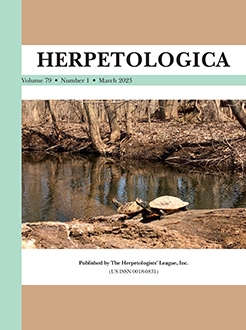Jeanine M. Refsnider, Nicholas Torres, Joshua G. Otten
Herpetologica 79 (1), 22-29, (8 March 2023) https://doi.org/10.1655/Herpetologica-D-22-00019
KEYWORDS: Bactericidal capacity, Graptemys geographica, heterophil:lymphocyte ratio, Kalamazoo River, Natural antibody agglutination
Environmental perturbations such as chemical spills often have immediate and obvious effects on the health of ecosystems and individual organisms. However, the long-term effects of such perturbations are less evident and often less well-understood. In July 2010, a ruptured pipeline spilled diluted bitumen into the Kalamazoo River in Michigan, USA, ultimately oiling 56 km of the river channel. During spill cleanup operations, the most common vertebrate species rescued from the oiled river channel was the Northern Map Turtle (Graptemys geographica), of which over 2000 individuals were captured, cleaned of oil, and released. We returned to areas along the 2010 spill gradient to determine whether turtles from locations that had experienced different magnitudes of oiling in 2010 differed in baseline stress levels or immune functioning in 2020, which was 10 yr after the oil spill. In 2020, we collected blood samples from 100 individual Northern Map Turtles along the 2010 spill gradient and subsequently quantified the heterophil:lymphocyte ratio, bactericidal capacity, and natural antibody agglutination. We found no correlation between turtles' 2020 capture locations relative to the origin of the 2010 oil spill and either mean stress level (heterophil:lymphocyte ratio) or immune functioning (bactericidal capacity and natural antibody agglutination ability). Thus, we found no evidence that Northern Map Turtles sampled along a gradient of oil exposure resulting from the 2010 Kalamazoo River oil spill experienced long-term effects on physiological stress levels or immune functioning. Importantly, our sampling did not include any individuals that may have died during 2010–2020 from poor health after the oil spill and therefore is biased toward healthy turtles remaining in the population. Interestingly, we found that a subset of turtles known to have been oiled in 2010 actually had higher natural antibody titers than turtles sampled from a control site that presumably had never been exposed to oil. We cannot exclude the possibility of other long-term effects of the oil spill on the Map Turtle population, such as decreased reproductive output. We recommend that long-term monitoring of populations and ecosystems be included in spill mitigation plans to track the recovery of populations and ecosystems over time and to document any effects that may become evident only years after the spill event.

